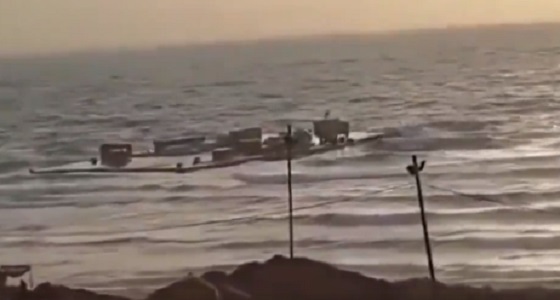International
‘Amateur Hour’: Biden Admin’s Floating Gaza Pier Problems Go From Bad To Worse

 From the Daily Caller News Foundation
From the Daily Caller News Foundation
By JAKE SMITH
New problems are mounting for the Biden administration’s $320 million floating Gaza aid pier which was already facing setbacks, despite becoming operational less than two weeks ago.
The U.S. military was forced to halt aid shipments to Gaza on Tuesday after the floating pier was damaged by bad weather over the weekend. The damage sustained from the bad weather is only the latest in a string of logistical and operational problems that have plagued the pier since it was constructed in mid May.
The JLOTS pier was a “horrible idea,” Michael DiMino, senior fellow at Defense Priorities and former CIA and defense official, told the Daily Caller News Foundation. “It’s a horrible idea due to the challenges that we just saw basically wreck the whole project.”
“It was never a sound plan to begin with… whether it’s accidents, or logistical hurdles, or risk to our troops and all these problems that have come to fruition. I don’t think that there should be any effort to try to continue this, or salvage it, or fix it,” DiMino said, pointing to safer, more effective methods of delivering aid to Gaza. “I think now is an opportunity to say this failed. Let’s wrap this up before we continue to tempt fate.”
Biden's floating pier in Gaza appears to be sinking pic.twitter.com/bN8WxSZLXh
— Daily Caller (@DailyCaller) May 28, 2024
Getting aid into Gaza via the JLOTS system requires several steps. Aid is first delivered by vessels to the floating pier off the shores of Gaza, where it is facilitated by U.S. officials. It is then picked up by loading vessels and transferred back to a separate causeway pier attached to the shores of Gaza, then trucked by various aid groups to warehouses for distribution.
Pentagon spokeswoman Sabrina Singh confirmed that U.S. aid deliveries had been halted after rough weather and choppy waters broke the causeway pier apart on Tuesday, rendering it useless for the time being. The pier will be removed from the coast of Gaza and towed northbound to Israel for repairs; it will take “at least over a week” to fix the pier before it can be re-anchored on the Gaza coastline, Singh told reporters.
“We had a perfect storm of high sea states… creating not an optimal environment to operate this JLOTS pier,” Singh said Tuesday, responding to a question as to whether the pier is too fragile to withstand tough conditions. “Hopefully weather conditions won’t hinder it anymore [once it is operational again].”
The pier can only be operated during favorable sea conditions, in a maximum of three-foot waves and wind speeds not higher than 15 miles per hour. Aside from the minimum week timeline, reconstruction efforts cannot take place if sea conditions are poor, possibly adding further delays
The incident comes just a day after a separate stint of bad weather unmoored four U.S. Army vessels supporting the JLOTS system and sent them floating away from the operational site off the coast of Gaza. Two vessels floated north and were beached in Ashdod, Israel, while the other two anchored on the Gaza coast near the causeway. One of the vessels has been recovered, and the other three will be recovered by Thursday, Singh told reporters during Tuesday’s press briefing.
A video from the incident appears to depict U.S. soldiers from one of the beached vessels in Gaza stranded on the shores of Gaza while awaiting rescue, despite the Biden administration’s promise that there would be no U.S. “boots on the ground” in the region during JLOTS operations.
“This is amateur hour. It’s unacceptable that there’s so little planning that appears to have gone into this, to the point where half a dozen U.S. troops are washed ashore in a war zone surrounded by Hamas,” DiMino told the DCNF.
That problem was proceeded by another incident last week in which three U.S. troops suffered injuries during JLOTS operations. While exact details haven’t been disclosed — other than that it was a non-combat incident — two of the troops suffered minor injuries and the third was critically injured and subsequently evacuated to an Israeli hospital for emergency care; he is still in critical condition, Singh said Tuesday.
Days after the JLOTS system was constructed, shipments that made it to the shores of Gaza via the causeway and floating pier were quickly stolen off of trucks by crowds of hungry civilians, creating security concerns among aid groups responsible for distribution. The United Nations and U.S. have discussed alternate routes for trucks to transfer aid to warehouses in lieu of the incident.
There are also security concerns for the U.S. troops supporting the JLOTS operations. Pentagon officials, including Department of Defense Secretary Lloyd Austin, have admitted there is a baseline risk that Hamas operatives on the ground in Gaza could stage an attack on the causeway or fire at troops offshore.
More broadly, only a fraction of the aid needed to address the humanitarian needs of the millions of Palestinians in Gaza can be delivered via the JLOTS system, even when fully operational. U.S. officials have said that roughly 90 trucks worth of aid will be delivered to Gaza via JLOTS in the interim, and eventually up to 150 trucks once the system is at full capacity.
But the UN previously told the DCNF in a statement that hundreds of trucks of aid are needed on a daily basis.
“That makes the pier a relative drop in the bucket at best — a waste of $320 million American taxpayer dollars and the futile deployment of 1,000 U.S. service personnel,” Shoshana Bryen, senior policy director at the Jewish Policy Center, previously told the DCNF.
It is far safer and more effective to deliver aid to the Palestinians through other methods, chiefly by truck convoys through border crossings in Egypt to the south and Israel to the west, of which there are several. The international community has expressed concern that Israel and Egypt are not allowing enough aid to enter through these crossings, though Israel counters that it is already going to great lengths to ensure delivery; Egypt refused to allow hundreds of trucks worth of aid to enter Gaza through the Rafah border crossing until recently.
International
Pope Francis’ body on display at the Vatican until Friday

From LifeSiteNews
By Michael Haynes, Snr. Vatican Correspondent
Visitors are invited to pray before the late pontiff’s coffin inside the basilica through Friday evening ahead of Saturday’s funeral.
Pope Francis’ remains were translated into St. Peter’s Basilica this morning, where they will now be on display for the faithful to pay their respects until Friday evening.
In a ceremony replete with Gregorian Chant throughout the procession, the bodily remains of Pope Francis were brought into the Vatican basilica from the chapel of the Casa Santa Martha guesthouse, where they had been lying in state on Tuesday.
Pope Francis’ coffin is brought into St Peter’s Basilica to the singing of the Litany of the Saints
His remains will now be on display until 7pm on Friday, for those who wish to pray for his soul by his coffin. https://t.co/78Ij3fmlgq pic.twitter.com/2k4gB0izCE
— Michael Haynes 🇻🇦 (@MLJHaynes) April 23, 2025
Faithful and others wishing to view the late pope’s remains will now have a chance to do so prior to his funeral on Saturday:
- Wednesday 23 April: 11:00 a.m. until midnight.
- Thursday 24 April: 7:00 a.m. until midnight.
- Friday 25 April: 7:00 a.m. until 7:00 p.m.
At 8 p.m. on Friday evening, Cardinal Kevin Farrell, the Papal Camerlengo, will preside over the right of closing of the pope’s coffin in readiness for his funeral the next morning.
Francis died at 7:35 a.m. on Monday morning, and his death was announced to the world a little over two hours later. In accordance with ecclesial law, his death was certified by the camerlengo that day and the papal apartments he used sealed – not to be opened again until the arrival of the new pontiff.
On Tuesday his remains lay in state in the chapel of the Casa Santa Martha guesthouse, which he had made his home for the duration of his 12-year reign rather than the Apostolic Palace and the papal apartments.
His death has triggered an outpouring of statements from world leaders expressing their sympathies, with many now due to be in attendance at Saturday’s funeral. Figures such as Donald Trump, Volodymyr Zelensky, Keir Starmer, Emmanuel Macron, and Prince William are expected at the Vatican this coming weekend.



In addition, many thousands of pilgrims who had been due to attend the now cancelled canonization of Blessed Carlo Acutis are also expected to attend the funeral.
As for the start of the conclave itself and the rounds of voting to elect a new pope, the Church’s law stipulates that this must begin between 15 and 20 days after the pope dies. In this case, that would mean starting around May 6 at the earliest, and May 11 at the latest.
Pre-conclave General Congregation meetings have already started as of Tuesday morning, with the second taking place on Wednesday afternoon. These events provide an opportunity for cardinals to get to know one another, as well as to formalize practical details regarding the conclave.
Following the funeral, though, such meetings will take on an increasingly serious nature as cardinals look among themselves for a suitable candidate to become pope.
International
New York Times publishes chilling new justification for assisted suicide

From LifeSiteNews
Even happy, healthy lives without major issues can warrant needless ending if they are ‘complete.’
Notorious secular “ethicist” Peter Singer has co-authored an opinion piece in The New York Times positing a chilling new rationale for assisted suicide: the determination that one’s life is simply “complete.”
Princeton psychologist Daniel Kahneman died in March 2024 at age 90. His cause of death was not disclosed at the time, but a year later, The Wall Street Journal revealed that Kahneman had emailed friends the day before to tell them he was traveling to Switzerland to avail himself of the country’s legal physician-assisted suicide.
“I think Danny wanted, above all, to avoid a long decline, to go out on his terms, to own his own death,” WSJ journalist and longtime friend of the deceased Jason Zweig wrote. “Maybe the principles of good decision-making that he had so long espoused — rely on data, don’t trust most intuitions, view the evidence in the broadest possible perspective — had little to do with his decision.”
On April 14, The New York Times published a guest essay by the infamous Singer, a pro-infanticide Princeton bioethics professor, and philosophy professor Katarzyna de Lazari-Radek, who shared that they too knew of Kahneman’s plans and that days before he had told them, “I feel I’ve lived my life well, but it’s a feeling. I’m just reasonably happy with what I’ve done. I would say if there is an objective point of view, then I’m totally irrelevant to it. If you look at the universe and the complexity of the universe, what I do with my day cannot be relevant.”
“I have believed since I was a teenager that the miseries and indignities of the last years of life are superfluous, and I am acting on that belief,” Kahneman reportedly said. “I am still active, enjoying many things in life (except the daily news) and will die a happy man. But my kidneys are on their last legs, the frequency of mental lapses is increasing, and I am 90 years old. It is time to go.”
Singer and de Lazari-Radek argued that this was an eminently reasonable conclusion. “(I)f, after careful reflection, you decide that your life is complete and remain firmly of that view for some time, you are the best judge of what is good for you,” they wrote. “This is especially clear in the case of people who are at an age at which they cannot hope for improvement in their quality of life.”
“(I)f we are to live well to the end, we need to be able to freely discuss when a life is complete, without shame or taboo,” the authors added. “Such a discussion may help people to know what they really want. We may regret their decisions, but we should respect their choices and allow them to end their lives with dignity.”
Pro-lifers have long warned that the euthanasia movement devalues life and preys on the ill and distraught by making serious medical issues (even non-terminal ones) into grounds to end one’s life. But Singer and de Lazari-Radek’s essay marks a new extreme beyond that point by asserting that even happy, healthy lives without major issues can warrant needless ending.
“Instead of seeing every human life as having inherent value and dignity, Singer sees life as transactional: something you are allowed to keep by being happy, able-bodied, and productive — and something to be taken away if you are not,” Cassy Cooke wrote at Live Action News.
In America, nine states plus the District of Columbia currently allow assisted suicide. In March, Delaware took a step closer to becoming the 10th with its own legalization bill, although it has yet to become law. Another bill recently failed in Maryland.
Support is available to talk those struggling with suicidal thoughts out of ending their lives. The Suicide & Crisis Lifeline can be reached by calling or texting 988.
-

 2025 Federal Election1 day ago
2025 Federal Election1 day agoOttawa Confirms China interfering with 2025 federal election: Beijing Seeks to Block Joe Tay’s Election
-

 2025 Federal Election1 day ago
2025 Federal Election1 day agoHow Canada’s Mainstream Media Lost the Public Trust
-

 2025 Federal Election23 hours ago
2025 Federal Election23 hours agoBREAKING: THE FEDERAL BRIEF THAT SHOULD SINK CARNEY
-

 2025 Federal Election1 day ago
2025 Federal Election1 day agoReal Homes vs. Modular Shoeboxes: The Housing Battle Between Poilievre and Carney
-

 2025 Federal Election1 day ago
2025 Federal Election1 day agoCHINESE ELECTION THREAT WARNING: Conservative Candidate Joe Tay Paused Public Campaign
-

 COVID-191 day ago
COVID-191 day agoNearly Half of “COVID-19 Deaths” Were Not Due to COVID-19 – Scientific Reports Journal
-

 John Stossel1 day ago
John Stossel1 day agoClimate Change Myths Part 2: Wildfires, Drought, Rising Sea Level, and Coral Reefs
-

 Business22 hours ago
Business22 hours ago‘Great Reset’ champion Klaus Schwab resigns from WEF





